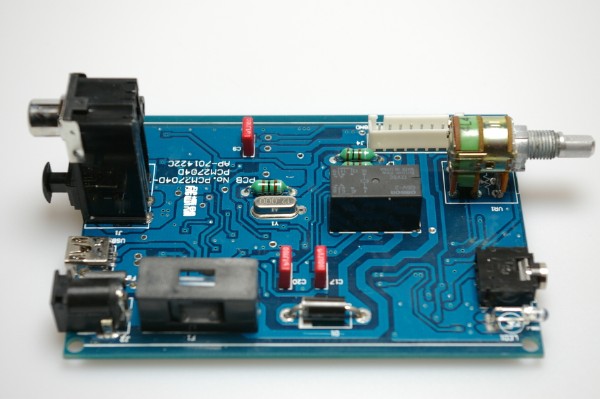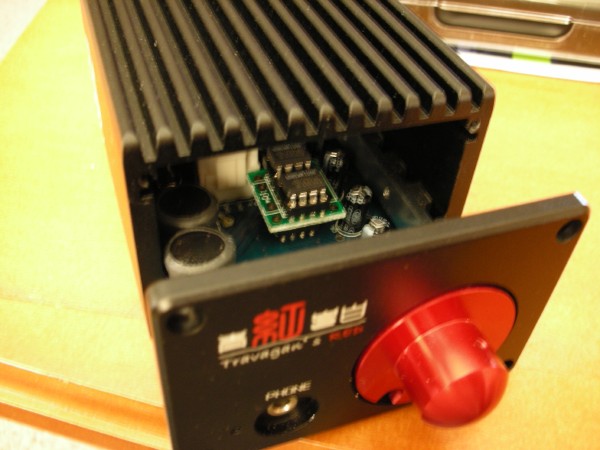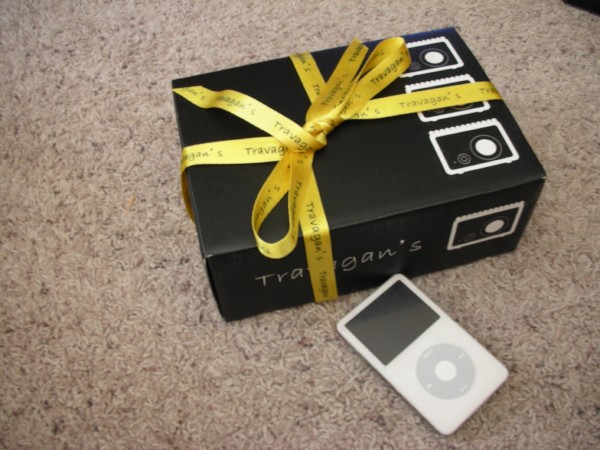- Joined
- Aug 18, 2007
- Posts
- 17,452
- Likes
- 839
I recently had the opportunity to review several new offerings by Travagans, whose online webstore can be found at Index-Travagan's shop
Travagans is a very young company specialized in professional audio products design. The company has been established for less than a year, and my contact is David Lin, formerly of Firestone Audio. Members of the company are personnel with years of factory management experience and experience in design of electronic products, R & D experience in electronic circuits and housing design. The company is located in Tainan City, Taiwan and their product lines are in Guangzhou, China.
Aside from operating their own brand Travagan, they also accept ODM projects at home and abroad. They are specialized in creating unique commodities and high value-added audio equipment and speakers, and they boast a number of patents for design. They do not compete in price with traditional manufacturers or China OEM manufacturers, yet they excel in design, quality and creativity.
Currently they offer 3 desktop amps, with different feature sets to cover a broad range of uses. Appearance from the front is similar, with them set apart by the color of the volume knob, and by differing dragon art on the side.
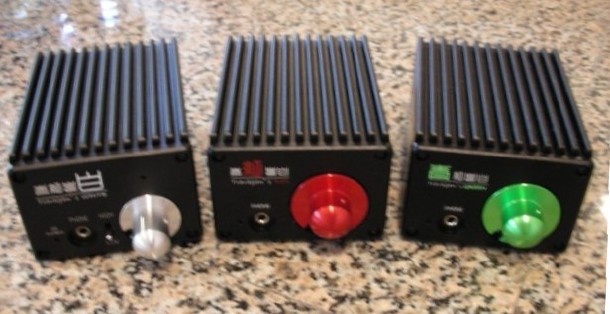
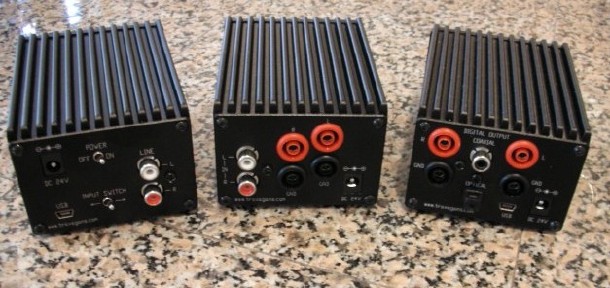
Sources: I used my Macbook core 2 duo 2.2Ghz, 5.5G 80gb iMod with V-cap dock, Apogee mini-DAC and Marantz CD5001 RCA out.
Program Material (aka music): Apple lossless files and CD - Tsuyoshi Yamamoto "Autumn in Seattle" in XRCD, FIM "This is K2 HD CD", FIM XRCD "Jazz at the Pawnshop", Diana Krall "Girl in the Other Room" Dual-Disc, Herbie Hancock "Gershwin's World" and "River", Melody Gardot "Worrisome Heart", Guinea Pig "Kool Cats", Christopher Hogwood Academy Ancient Music "Handel Messiah", Alison Krauss "A Hundred Miles or More", Jack Johnson "On and On", We The Kings title album, and Pink Floyd "DSOTM".
Headphones: ALO modded Ultrasone HFI-780, APS v3 re-cabled RS-1 and Edition 9 and HD600, APS v2 re-cabled Denon D2000, Livewires T1, and SE530 crammed into a Livewires custom shell (don't ask).
Photos: I will update this or the second post with my own photos, once I sort out hosting them where I don't have to eat the bandwidth at my own site.
The first Travagans Amplifier we'll cover is the "Green".
Travagans Green Front Panel

Travagans Green Rear Panel

Travagans Green Circuit Board

The Green has USB as it's sole input, but it has several outputs - among them a 1/8" headphone out that could be used as a line out, and it also includes a USB to S/PDIF converter so it has Optical out and Coax out on the rear panel. Finally it has speaker outs with banana jacks for quick and easy connection. Even when I unplug the included 24v PSU, the Green can be driven entirely by the Macbook USB 2.0 port with no internal battery, and there is only a small drop in sound quality and dynamics heard after careful listening. It is USB 1.1 compatible as well, but I do not know if a 1.1 port can power the amp without the PSU.
The power brick offers 100VAC~240VAC Auto-switching and is mandatory when driving speakers, typically being small speakers on your desktop for listening to your computer. Interestingly, it simultaneously drives both the speakers and the headphone jack at the same time, so to silence the speakers I had to unplug them. The amp is about the width and depth of an ipod video, and about 3" tall, so being able to listen to headphones on the laptop, and take it outside on the porch without a power adapter is a welcome option.
Other technical specifications include:
‧PCM2704 16-Bit DAC,32、44.1、48KHz sampling
‧S/PDIF Digital output (USB to S/PDIF)
‧DSIX Re-data Coaxial & Optical output
‧LM4562 for main speaker amplifier,current boosters made by NPN/PNP power transistors
‧Class AB / DC amplifier;coupling capacitor less
‧Extra low output resistance ( Zo < 0.05 ohms),high current capacity ( 1A per channel)
‧2Hz~120Khz, -1dB (at 8 ohms/2W loading),very low noise!
‧Max. output 5Vrms ( 5W for 4 ohms speaker)
‧OP amplifiers exchangeable! You can tune the tone by yourself!
‧Headphone amplifier output 80mW per channel
‧Power by 24VDC adaptor or 5VDC USB line (DAC & Headphone only)
‧“Anti-dummy” power supply protection
‧Size: 110mm (L) X 76mm(W) X 57mm(H)
‧Weight: 450g
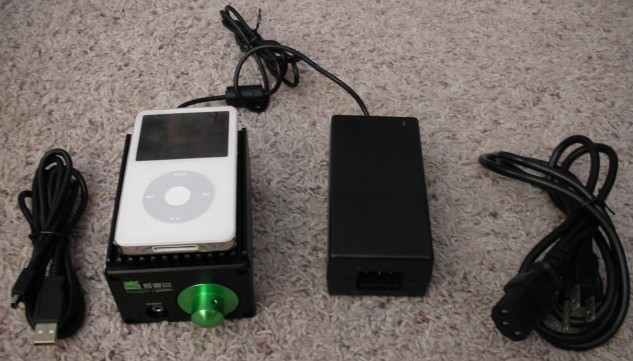
Headphone Output: I listened to the Green with headphones right out of the box, before proceeding with a 150 hour burn-in. David Lin felt that 24 hours would be enough, but I found it did go through some subtle changes over the first 75-100 hours or so. Just in the first 6-7 hours with it I liked it very much with my ALO modded HFI-780.
The sound is great, with warm mids that make saxophones sweet and rich and vocals sound intimate. It has crisp clean highs without grain to them, and once it reached about 75 hours the frequency response seems to be smooth and balanced, without unnecessary colorations. It has a present but neutral level of bass, which is not as punchy as the Pico or Predator. This made the Green well suited to cans with heavy bass like my Denon D2000, ALO modded Ultrasone HFI-780 and Edition 9, but it seemed just a tiny bit thin with the Grados (most with APS re-cable). It also did very well with my re-cabled HD600 which are not known to be bass heavy, nor easy to drive. As I said before, the mids are rich and sexy with female/male vocals and saxophones/pianos are especially well produced. It seems to have good extension at the lower and upper extremes of the sound spectrum, and no glaring flaws.
The Green is fairly transparent, but when compared to better DACs I felt the air around instruments is a little darker or lacking a little. When enjoyed on it's own merits, this wasn't a problem, and it is very detailed and neutral. But when compared to better DACs then it just seems that the lower threshhold for hearing sounds between notes seems to occur sooner, so between notes it can be darker/blacker, like nothing is there. This is unlike with Pico, Predator, HR Micro DAC and even iBasso D1/D2 with DAC - where you can hear more reverberations or echos from the environment, allowing the sound's decay to go on longer before the sound disappears altogether. However, vs the Headstage Lyrix with DAC, the Green had similar ambience, but more intimate and rich mids, which I liked. Also, I want to stress that ambience is not a major fault in the Green, as it is still there, it's just more limited by the less expensive DAC which still beats my Macbook headphone out for sound quality.
Overall, the Green is quite enjoyable and pleasant to listen to with headphones, and if my D1 or D2 were still stock the Green would beat them by being smoother, more balanced and forward sounding (the stock D1 is a little edgy and distant sounding, and stock D2 doesn't present the enjoyable rich lush mids of the Green).
One problem was noted when walking around on the carpet wearing socks, there could be static discharges that would cause the amp to shut down for a short period. This seemed more related to the PSU that was laying on the carpet a foot or two away, being closer to me than the amp was at the times that it happened. The only other issue I noted was with high efficiency In Ear Monitors (IEM) like SE530 and Livewires, where there was some hiss between songs and when paused. Normal listening covers it up, but it is possible to play low enough to hear hiss along with the music, right at the edge where the volume knob has some channel imbalance at 8:30 and below. This typically is not an issue, but a Shure volume attenuator with the volume knob rotated only 3-4 mm eliminates the hiss, with minimal impact on the sound quality (estimate 30 ohms added).
Speakers Outputs: Of course I tested the speaker output of the Green, first with the 2" Travagans speakers, and then my own.
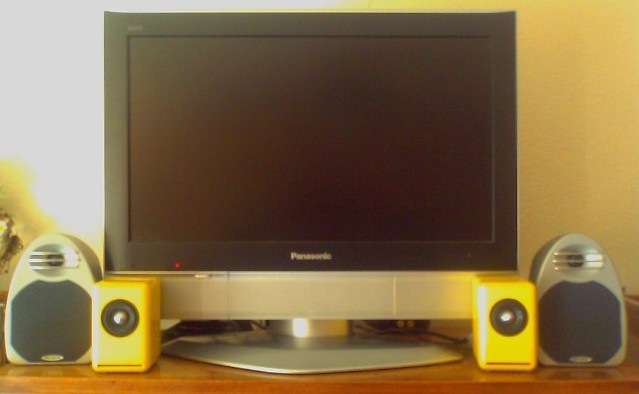
Here are the Published Technical specifications of the Travagans speakers:
■ Black、Red、Blue、Yellow 4 colors
● High quality driver with shielded neodymium motor
● Solid aluminum phase plug
● Very good frequency response
● Handcrafted cabinet with high gloss paint
■ Cabinet: 10mm MDF,high gloss paint
■ Driver: 2” Full Range shielded driver
■ Frequency: Response 180Hz~20KHz ;-3dB
■ SPL: 86dB@ 1M/1W
■ Impedance: 8 ohms
■ Power: Handing Normal 10W Maximum 15W
■ Weight: 0.6Kg/ps
■ Dimensions: 10cm X 8cm X 13cm (H X W X D)
■ Banana jacks incorporated into the speaker binding posts which unscrew to allow using bare speaker cable ends as well
With the 2" full range speakers, the bass was pretty much missing. I found using the SRS iWOW iTunes plug-in helps to adjust the EQ to make them have the illusion of bass from a small speaker, and to open up the soundstage at the same time. The regular EQ was not as helpful for increasing the bass, since the drivers just can't move enough air, but the SRS iWOW increases the harmonics that would go along with the low notes to give the illusion of bass. I found the headphone jack is active at same time as the speakers. This was still a helpful feature because I could use the headphone out to drive a 40 watt Sharper Image subwoofer that I had laying around, which definitely helps to compliment the small satellites. There were a few times when I forgot to unplug the headphones while playing the speakers loudly, and once or twice I would overload the PSU, which shuts off for a short period to recover. I was also able to test the Green with my Velodyne 2-Way bookshelf satellites (from a 5.1 home theater speaker package), but I still found the upper and lower ends of bass and treble and extension to be lacking, although this seemed to be improving to burn-in over time. Nevertheless, I was not encouraged going into the next part of my testing - driving a STAX electrostatic headphone transformer via the speaker outputs.
Surprise Feature: There are a lot of vintage electrostatic headphones out there, that come with a transformer box to plug into the speaker outputs of a full size amplifier, supplying the 230 volt bias supply charge to the drivers. Usually an amplifier with 5-50 watts of power is chosen, often times a vintage Fisher or Sansui or Marantz, although the transformers typically don't require more than 5 watts to be used to actually drive them and the rest is "reserve" power. Other times, a small modern amp like a T-amp for $60 (Parts-Express.com) or Trends TA-10 for $150 (Audio Line Out) are chosen. So, it occurred to me that this might be an opportunity to have a small amp, that is not buried in my home entertainment center, to drive my vintage STAX via laptop.
Well, I am happy to report that I am able to drive an SRD-7 transformer via a Travagans Green amplifier, to power my SR-5 Gold Edition and SR-Lambdas. With music playing it took a few minutes to charge up the self biasing transformer, and probably 15-30 minutes for full volume but I had a slight channel imbalance with right louder than left. I hadn't used the SRD-7 in months, and after about 45-60 minutes of warmup the channel imbalance was gone. After that, the headphones sounded quite nice, much better than the speaker performance led me to believe was possible.
I am guessing the amp is pushing 3-5 watts into the SRD-7, and while the Green's specs are 5 watts into 4 ohms, I have no idea what load the SRD-7 places on the amp. I typically use an older SRD-5 with 117v AC when pairing with low power amps, instead of the self biasing SRD-7, so as to avoid dropouts and slow charging. At least I did not experience any sound drop-outs at all. Normally the bare minimum mini-amps that one has to use to drive STAX don't have a headphone out, or a DAC, or S/PDIF converter built-in - but the Green has it all. In the end, my STAX SR-5 and SR-Lambda sounded pretty good with Travagans amps driving them. It was a simple process to install 4 Monster cable gold plated banana plugs ($15) onto the input cable of the SRD-7 transformer.
S/PDIF output: Chips like PCM2704 in the Green are supposed to do a better job converting to S/PDIF (or I2S) than to analog, and then passing it along to a better DAC, like what the amp builders did with the Pico and iBasso D2. So, I would think the USB to Optical would result in a better quality output, than the limitations of the PCM chip's analog out. I found this to be the case. Using the Green for USB input to S/PDIF conversion, and feeding the Green's optical out to my iBasso D1 and HeadRoom Micro DAC, was similar in sound quality to connecting the HR or iBasso directly to the USB with their own USB DAC. Their superior Cirrus Logic CS4398 DAC chips can simply do a better job converting the S/PDIF to analog than the PCM2704 could. The result was a little better sounding than the Green analog output, with more air around instruments and better ambience.
The S/PDIF output of course is intended to be a way to interface the computer with not just your headphones and desktop speakers, but also to your home stereo system or to higher-end DAC's and amplifiers that don't have USB capability. Let's say you have a home theater built around your computer, such as in your bedroom. With the Travagans Green you can sit at the computer or laptop and listen to music with headphones or speakers while you work at it, and then later climb into bed or an easy chair and listen to your movie or music through the stereo with it's superior DAC and amplifier.
In my case, all the stand-alone DACs that I own with optical inputs also have USB inputs built-in (Wai Wai Valve Co, iBasso D1, HR Micro DAC, Apogee mini-DAC), so I don't have much need for a USB-to-S/PDIF converter. All of mine have a high end DAC chip to do the conversion after the USB receiver chip passes on the S/PDIF or I2S signal. The double whammy is I already have a 24/96 optical out from my Macbook, so I am not restricted to USB output only. But few computers have optical out, and some DAC/amps don't do USB - such as the excellent Octavert 01 which only has Optical and Coax input, or the Apogee mini-DAC where USB has now been discontinued. This is where the Green come in handy to allow digital out of the computer into those higher-end optical or Coax DAC.
Next is the Travagans "Red": The Red gives up the USB input with S/PDIF outputs, and accepts a standard RCA analog input instead. While the Green is unable to accept ANY analog input, the Red can be connected to your current DAC analog outputs, or CD/DVD player, or your DAP like an iPod or Zune, and just about anything else you can think of like computer line out, PDA or music phone, etc... The Red still offers speaker outputs, and uses similar amplifier topology, as far as I can tell.
Travagans Red Front

Travagans Red Rear

Travagans Red Circuit Board

Features per Travagans website:
■ RCA Input X 1
■ Speaker Output X 1
■ 3.5mm Headphone Output X 1
■ Full Metal Case
■ 100VAC~240VAC Auto-switching
■ Well Done Package
■ RoHS product
Technical specifications:
‧LM4562 for main amplifier,current boosters made by NPN/PNP power transistors
‧Class AB / DC amplifier;coupling capacitor less
‧Extra low output resistance ( Zo < 0.05 ohms),high current capacity ( 1A per channel)
‧2Hz~120Khz ,-1dB (at 8 ohms/2W loading),very low noise!
‧Max. output 5Vrms,easy to match 8Ω speaker to 600Ω headphone
‧OP amplifiers exchangeable! You can tune the tone by yourself!
‧Power by 24VDC 100V/240V input auto-switching adaptor
‧“Anti-dummy” power supply protection
‧Size: 110mm (L) X 76mm(W) X 57mm(H)
‧Weight: 420g
The Red was even more transparent than the Green, because of the ability to feed it an even higher quality audio from a good source. So, the air and ambience that is slightly lost in the Green's DAC could be heard with the Red. This not to say the Green is bad, but just that the Red is better. I did not notice much difference in sound signature or quality, apart from the improved ambience from improved sources. Compared to the Meier HeadFive, the Red sounds to be an upgrade to the HeadFive, with smoother highs and more transparency. The mids were very similar, as was bass, but the Travagans seemed to be a little quicker, punchier and more responsive and not as laid back as the HeadFive. As well see later, the Red gets even better with some rolling of the opamps.
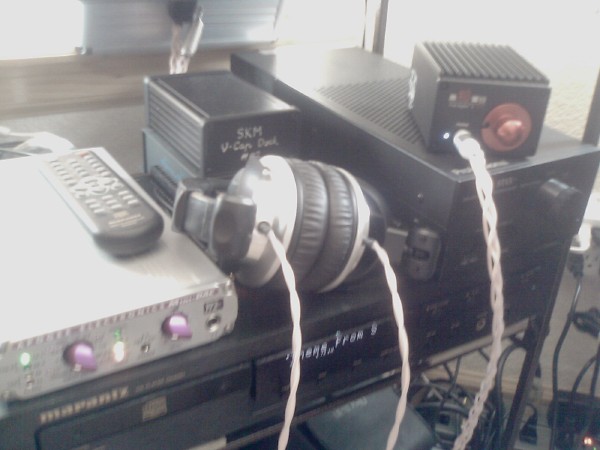
Last but not least, we come to the Travagans "White":
The White gives up the speaker jacks for both analog and USB inputs, and therefore the PSU is much smaller, but still a 24v wallwart. The Stepped Attenuator is actually still a swept potentiometer, with notches that simply click and hold the knob. It is possible to select volume levels in positions between the clicks, and it is a higher quality pot with less channel imbalance at the lowest volume levels. The White introduces a High/Low gain switch, but it has so much power I found there really is no need to use the high gain - so again it is not the best for those high efficiency IEMs.
Travagans White Front

Travagans White Rear

Travagans White Circuit Board

The "White" amp is just as quick and detailed and transparent as the Red, with similar sweet and warm mids as the Red and Green amps. However, the bass seemed to be just a little bit thinner with my Grados, although it was more than sufficient for my Denon D2000, Sennheiser HD600, and all my Ultrasones including HFI780, Proline 2500, and Edition 9. I compared it directly to my Meier HeadFive, and felt they were very similar, but the White was better able to drive my Grados than the HeadFive. With the Grados the White also held a slight edge in other areas including more bass, better transparency, and smoother highs - while the HeadFive was able to match the rich and lush mids that are so appealing.
For those that don't need the speaker driving capability, and would like to have analog input and USB input, the White is a much better option than the Green which can only be used with a computer. But overall I have to say the Red is my Favorite, not just for the ability to drive a STAX transformer, for reasons I will get to in my next section.
Opamp Rolling:
A nice feature of the Travagans amps is the ability to roll in your own opamps, to find better synergy with your headphones or to tune the sound to your liking, if the OEM opamp doesn't tickle you. I found the stock LM4562 to be very good, but sometimes a little bright and sometimes a little light on the bass, depending on the headphone. The LM4562 was very good with Denon D2000 and HD600, and all my Ultrasone (PL2500, HFI780 and Edition 9) but it needed just a little more bass with the Grado RS-1 and RS-2.
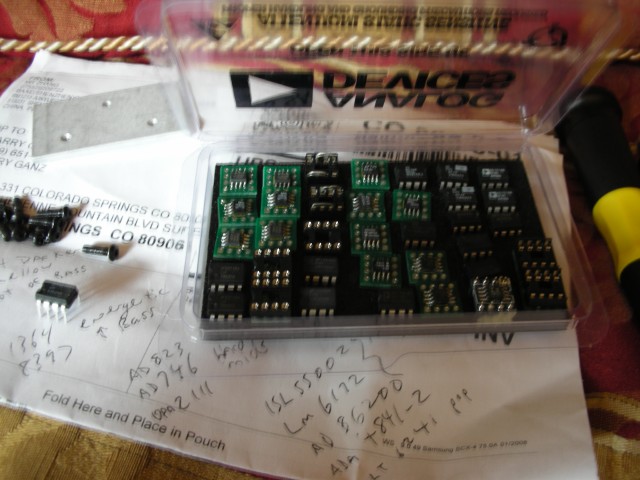
I started opamp rolling with the White, and after trying 11 opamps I found TWO winners - the LT1364 and the AD8397 seem to offer the increased bass and energy that the Grados need, while retaining most of the good qualities of the LM4562 (crisp treble, warm mids, transparency, detail, realism). Interestingly, while those two opamps were an improvement, I returned the White back to the LM4562 for the time being. The LM4562 wasn't bad vs those two, and I wanted to spend more time with it. Later, if I decide to swap opamps for the long term, I will make a better effort to decide between the LT1364 and AD8397. But, they were very close to each other, and only slightly better than the stock opamp when tested with a small and brief subset of my review music.
Then there were the losers, which failed to improve the White. I tried the AD8066 and it seemed slightly darker, more mellow, and had a lot of bass - in fact, more than I wanted. I also tried the OPA2111, AD746 and AD823 and felt they were all similar and all had more energy and PRaT, but the uppers mids seemed harsh and congested with all of these. The opamps that didn't work at all (high pitch whine, with or without music heard), were the ISL55002. LM6172, AD8620, and AD4841-2. I heard a pop with the LTC6241HV, and haven't tried to find out if I killed it yet. I didn't have time to try the LME49720 (sucessor to the LM4562), LT6234, LMH6643, or LMH6655.
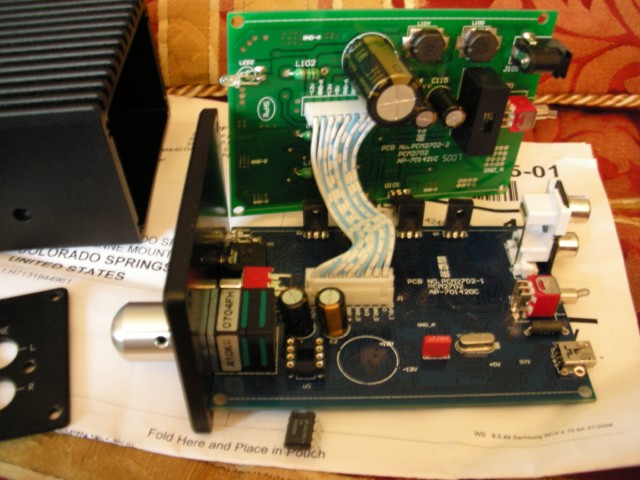
There is no room in the White to try a side-by-side 2:1 adapter for single channel opamps, so I moved on to the Red amp next. I first tried the OPA627 and fell in LOVE with the sound. The sound signature reminds me of my maxed out Woo Audio WA6 tube amp, with expensive metal base GZ34 rectifier (total cost new around $1,000 - 1,200 with the upgrades and tubes). The OPA627 produced very neutral and clean sound, with good bass and warm rich mids.
Compared to the Woo there is still less ambience and airyness around the instruments, and a little less treble than the Woo which offers better treble extension - but the OPA627 brought them much closer together. Blutarsky from here at head-fi listened to the amps with me and agreed with my assessment, that there is no way that a $190 amp with $30 worth of opamps should be able to sound like 90% of a $1,000 amp and tubes. As a side note - The Woo only has about 600 hours on it, but with the huge V-caps and BlackGates caps the WA6 is supposed to take 1,000 hours to fully burn-in, so it will continue to improve over time. That last 10% makes all the difference, and the Woo has it and more.
The OPA627 in the Red is also similar in sound to the headphone out on my Apogee Mini-DAC, and it sounds good with any of my headphones. Wow. I was tempted to stop right there and not test any more single channel opamps. However, I moved on to the AD797 next. This definitely adds more bass to the Grados, but the bass was a bit too heavy with the Denon and Ultrasones. It also has a slight grating or grainy quality to the highs, which just weren't as smooth as with the stock opamps or the OPA627. I decided to move on to another of my favorites, the AD743.
Another WOW, then as I listened more, OMG! The AD743 offers the slightly more sparkly highs that the OPA627 didn't quite attain, along with a stronger bass and presence that is not overpowering like the AD797. The highs are definitely much smoother than those of the AD797 as well, while the mids are sweet like honey. The music flows very well, and is very transparent. I decided to leave the AD743 in the Red for now, as there is no question it is now better with everything, and any headphone. At this point, aside from my Apogee mini-DAC, the Travagans Red with AD743 is now the second best SS amp in the house, and nipping at the heels of the Apogee. Who knows, with time I might become convinced it is better. The AD743 is the opamp set was previously my favorite in my iBasso D1, so it's no surprise it is such a big winner here too. I am not convinced that there could be a better choice of opamps than the AD743 for the Travagans. If you find one, let me know and maybe I'll try it. I decided not to try any others in the Red, and to just leave the AD743 in place. As the old saying goes, "if it aint broke, don't fix it."
One last Photo of the Travagans stacked on top of Meier HeadFive, stacked on top of a dusty old spare STAX SRM-1 Mk2 - a nice comparison of sizes.
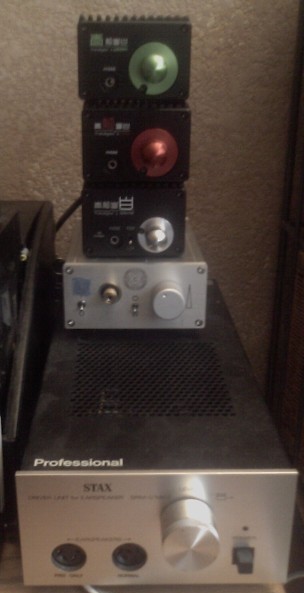
Now for the Encore: Travagans "Colors" mini Headphone Amplifier (For iPod/MP3/MP4)
Travagans Colors

Travagans Colors with iPod

Features - Provided by Travagans:
■ Environmental-friendly, good hand-feel shell material.
■ Four colors available.
■ Equipped with rechargeable lithium ion Battery, no memory effect
■ Rechargeable lithium ion battery is designed to prevent over charge / discharge, it will shut off automatically when charge completed.
■ When charge completed, it can run for 24 hours!
■ USB port is available for recharging, can be connected to any computer.
■ Comes with premium package and accessories.
This is a very small "Dog Bone" shaped silicone encased audio booster. It's pretty darn cute I say. I call it a booster, as it does not have a volume control, and is intended to provide more "driving power" to the headphone out on a portable music player. These days some MP3 players or PCDP only provide a pathetic 5mw of power per channel, which can in no way drive the more demanding headphones or IEM adequately.
"Colors" is about the length of a 3G nano, half as wide, but about twice as thick. The bundle includes a nice canvas and leather roll-up case with pouches to hold the different items. In the bundle are 3 different sized silicone straps, like uber-tiny live strong arm-bands, to hold it to your MP3 player. You can leave the "Colors" connected to the Nano headphone out all the time, and it only turns on when you plug in the headphones. I used a small 4" 90 degree mini-mini interconnect from Headstage, because the 2 included interconnects were just too long for portable and mobile listening, but good for sitting at the desk or couch to listen. It also includes a USB cable for charging via the mini-usb port on the Colors.
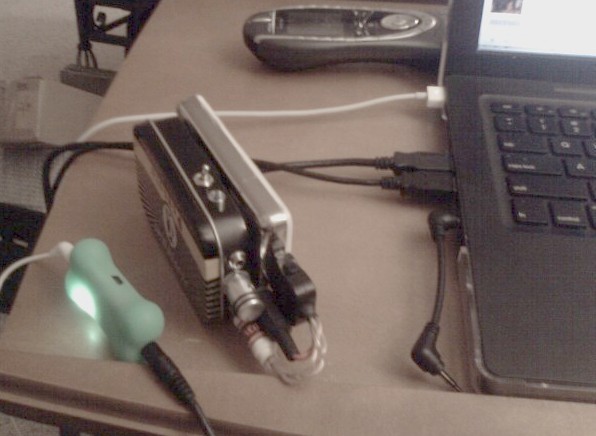
The Colors has two LED that shine through the silicone cover. One lights up when it is being charged, and another that lights up when the amp is powered on. When the battery is low, the Power-On LED blinks and the sound blanks out during the blinking, and after a very short period the amp powers off. I never was able to confirm how long it takes to fully charge it, because when it is plugged into USB the Charge LED stays on for as long as it is plugged into USB. With use I got about 12 hours of play time for the first two charge/discharge cycles, and up to 15 hours after that, but then I stopped testing battery life and left it on USB power and running on my laptop for 150 straight hours for burn-in.
I approached listening to this differently than the usual headphone amplifier review, because it seems it's purpose was for difficult to drive portable headphones but not for audiophile listening. My Altec Lansing IM716 with variable resistor podectomy meet that criteria. They are mediocre at best when driving via headphone out, and blossom into something great when feed enough juice to make them sing. With my DanT modded IM716 I can tune them to match the amp, by choosing to add differing impedances - 22, 33, 47, 55, 69, 80 or 102 ohms to the "de-podded" IM716.
The Colors definitely adds punch and depth to the sound of the IM716, and allows more volume and bass. It faithfully reproduces the sound the way it comes from the analog source, and as the source improves so does the sound. I really enjoyed listening to it via my Headstage USB DAC cable, and then using the Macbook's digital volume control to adjust the volume.
So, for a lark I grabbed my RS-1 which have been re-cabled with a 6 foot APS v3 cable and 1/8" plug for portable use (all my other headphones had already been returned to their cases). Amazingly, with the RS-1 the $59 Colors driven by my Headstage PCM2702 USB DAC has a sound signature that is very similar to the Travagans Green. Nice.
The main negative was that Colors was sensitive to RF interference from the computer, and the hard drive spinning could interfere with the Colors and inject noise, unless I let it dangle off the desk as far away from the computer as possible. Just covering the Colors with my hand was enough to block the interference if it was right next to the Macbook. It was much noisier when trying to listen to it while the USB was plugged in to provide power. The second negative is the lack of a volume control, to take advantage of a portable source's line-out - fortunately some DAC have digital volume control, and some DAP have great headphone out (iRiver H140, D-303, D-25s).
I still think this is best used as a battery-only device, and with small portable audio players. While the sound won't match that of the $59 PenguinAmp Caffeine with iMod, the Caffeine/iMod can't as easily fit in a front shirt pocket with a 3G nano, nor is it as indestructable as the Colors!
So, there you have it, most of the Travagans product line, as best as I am able to present it. I hope this helps all of you to make some wise choices about your equipment, and sorry about your wallet!
Travagans Black - updated 10/05/08:
I have been spending some time with the Travagans Black - which is a power regulator and stabilizer that goes between the Red and Green or White and the power brick. It's basically like having a Sigma 11 PSU for the amps, but it has a much bigger/longer power supply reserve than my 24v Sigma 11. Power can be unplugged for several seconds and turned back on and there is no audible influence on the sound.
I find the music background to be very black and dynamic range to be slightly improved, with not only the Travagans amps but also when used with a beta loaner 24v Grahm Slee NOVO discrete SS amp and my 24v Super Pro DAC707. With the Red and Green, it seems to give more drive power to their Speaker out for driving my electrostatic headphone transformer, and renders more bass through the electrostatic headphones along with the blacker background and better dynamics.
Using it with the DAC the sound is refined even more, and the frequency extension or depth seems better as well - the Black takes an entry level optical input DAC and brings it up to the level of my Headroom Micro DAC which is very good (DAC707 has same chip set as HR, but I haven't tested the USB input on DAC707 to see if it's as good as the Headroom).
I think the Travagans Black is a worthy addition to ANY 24v electronic audio device. However, it's design does match the Travagans, and it stacks well above or below the Red/Green/White.
Travagans is a very young company specialized in professional audio products design. The company has been established for less than a year, and my contact is David Lin, formerly of Firestone Audio. Members of the company are personnel with years of factory management experience and experience in design of electronic products, R & D experience in electronic circuits and housing design. The company is located in Tainan City, Taiwan and their product lines are in Guangzhou, China.
Aside from operating their own brand Travagan, they also accept ODM projects at home and abroad. They are specialized in creating unique commodities and high value-added audio equipment and speakers, and they boast a number of patents for design. They do not compete in price with traditional manufacturers or China OEM manufacturers, yet they excel in design, quality and creativity.
Currently they offer 3 desktop amps, with different feature sets to cover a broad range of uses. Appearance from the front is similar, with them set apart by the color of the volume knob, and by differing dragon art on the side.


Sources: I used my Macbook core 2 duo 2.2Ghz, 5.5G 80gb iMod with V-cap dock, Apogee mini-DAC and Marantz CD5001 RCA out.
Program Material (aka music): Apple lossless files and CD - Tsuyoshi Yamamoto "Autumn in Seattle" in XRCD, FIM "This is K2 HD CD", FIM XRCD "Jazz at the Pawnshop", Diana Krall "Girl in the Other Room" Dual-Disc, Herbie Hancock "Gershwin's World" and "River", Melody Gardot "Worrisome Heart", Guinea Pig "Kool Cats", Christopher Hogwood Academy Ancient Music "Handel Messiah", Alison Krauss "A Hundred Miles or More", Jack Johnson "On and On", We The Kings title album, and Pink Floyd "DSOTM".
Headphones: ALO modded Ultrasone HFI-780, APS v3 re-cabled RS-1 and Edition 9 and HD600, APS v2 re-cabled Denon D2000, Livewires T1, and SE530 crammed into a Livewires custom shell (don't ask).
Photos: I will update this or the second post with my own photos, once I sort out hosting them where I don't have to eat the bandwidth at my own site.
The first Travagans Amplifier we'll cover is the "Green".
Travagans Green Front Panel

Travagans Green Rear Panel

Travagans Green Circuit Board

The Green has USB as it's sole input, but it has several outputs - among them a 1/8" headphone out that could be used as a line out, and it also includes a USB to S/PDIF converter so it has Optical out and Coax out on the rear panel. Finally it has speaker outs with banana jacks for quick and easy connection. Even when I unplug the included 24v PSU, the Green can be driven entirely by the Macbook USB 2.0 port with no internal battery, and there is only a small drop in sound quality and dynamics heard after careful listening. It is USB 1.1 compatible as well, but I do not know if a 1.1 port can power the amp without the PSU.
The power brick offers 100VAC~240VAC Auto-switching and is mandatory when driving speakers, typically being small speakers on your desktop for listening to your computer. Interestingly, it simultaneously drives both the speakers and the headphone jack at the same time, so to silence the speakers I had to unplug them. The amp is about the width and depth of an ipod video, and about 3" tall, so being able to listen to headphones on the laptop, and take it outside on the porch without a power adapter is a welcome option.
Other technical specifications include:
‧PCM2704 16-Bit DAC,32、44.1、48KHz sampling
‧S/PDIF Digital output (USB to S/PDIF)
‧DSIX Re-data Coaxial & Optical output
‧LM4562 for main speaker amplifier,current boosters made by NPN/PNP power transistors
‧Class AB / DC amplifier;coupling capacitor less
‧Extra low output resistance ( Zo < 0.05 ohms),high current capacity ( 1A per channel)
‧2Hz~120Khz, -1dB (at 8 ohms/2W loading),very low noise!
‧Max. output 5Vrms ( 5W for 4 ohms speaker)
‧OP amplifiers exchangeable! You can tune the tone by yourself!
‧Headphone amplifier output 80mW per channel
‧Power by 24VDC adaptor or 5VDC USB line (DAC & Headphone only)
‧“Anti-dummy” power supply protection
‧Size: 110mm (L) X 76mm(W) X 57mm(H)
‧Weight: 450g

Headphone Output: I listened to the Green with headphones right out of the box, before proceeding with a 150 hour burn-in. David Lin felt that 24 hours would be enough, but I found it did go through some subtle changes over the first 75-100 hours or so. Just in the first 6-7 hours with it I liked it very much with my ALO modded HFI-780.
The sound is great, with warm mids that make saxophones sweet and rich and vocals sound intimate. It has crisp clean highs without grain to them, and once it reached about 75 hours the frequency response seems to be smooth and balanced, without unnecessary colorations. It has a present but neutral level of bass, which is not as punchy as the Pico or Predator. This made the Green well suited to cans with heavy bass like my Denon D2000, ALO modded Ultrasone HFI-780 and Edition 9, but it seemed just a tiny bit thin with the Grados (most with APS re-cable). It also did very well with my re-cabled HD600 which are not known to be bass heavy, nor easy to drive. As I said before, the mids are rich and sexy with female/male vocals and saxophones/pianos are especially well produced. It seems to have good extension at the lower and upper extremes of the sound spectrum, and no glaring flaws.
The Green is fairly transparent, but when compared to better DACs I felt the air around instruments is a little darker or lacking a little. When enjoyed on it's own merits, this wasn't a problem, and it is very detailed and neutral. But when compared to better DACs then it just seems that the lower threshhold for hearing sounds between notes seems to occur sooner, so between notes it can be darker/blacker, like nothing is there. This is unlike with Pico, Predator, HR Micro DAC and even iBasso D1/D2 with DAC - where you can hear more reverberations or echos from the environment, allowing the sound's decay to go on longer before the sound disappears altogether. However, vs the Headstage Lyrix with DAC, the Green had similar ambience, but more intimate and rich mids, which I liked. Also, I want to stress that ambience is not a major fault in the Green, as it is still there, it's just more limited by the less expensive DAC which still beats my Macbook headphone out for sound quality.
Overall, the Green is quite enjoyable and pleasant to listen to with headphones, and if my D1 or D2 were still stock the Green would beat them by being smoother, more balanced and forward sounding (the stock D1 is a little edgy and distant sounding, and stock D2 doesn't present the enjoyable rich lush mids of the Green).
One problem was noted when walking around on the carpet wearing socks, there could be static discharges that would cause the amp to shut down for a short period. This seemed more related to the PSU that was laying on the carpet a foot or two away, being closer to me than the amp was at the times that it happened. The only other issue I noted was with high efficiency In Ear Monitors (IEM) like SE530 and Livewires, where there was some hiss between songs and when paused. Normal listening covers it up, but it is possible to play low enough to hear hiss along with the music, right at the edge where the volume knob has some channel imbalance at 8:30 and below. This typically is not an issue, but a Shure volume attenuator with the volume knob rotated only 3-4 mm eliminates the hiss, with minimal impact on the sound quality (estimate 30 ohms added).
Speakers Outputs: Of course I tested the speaker output of the Green, first with the 2" Travagans speakers, and then my own.

Here are the Published Technical specifications of the Travagans speakers:
■ Black、Red、Blue、Yellow 4 colors
● High quality driver with shielded neodymium motor
● Solid aluminum phase plug
● Very good frequency response
● Handcrafted cabinet with high gloss paint
■ Cabinet: 10mm MDF,high gloss paint
■ Driver: 2” Full Range shielded driver
■ Frequency: Response 180Hz~20KHz ;-3dB
■ SPL: 86dB@ 1M/1W
■ Impedance: 8 ohms
■ Power: Handing Normal 10W Maximum 15W
■ Weight: 0.6Kg/ps
■ Dimensions: 10cm X 8cm X 13cm (H X W X D)
■ Banana jacks incorporated into the speaker binding posts which unscrew to allow using bare speaker cable ends as well
With the 2" full range speakers, the bass was pretty much missing. I found using the SRS iWOW iTunes plug-in helps to adjust the EQ to make them have the illusion of bass from a small speaker, and to open up the soundstage at the same time. The regular EQ was not as helpful for increasing the bass, since the drivers just can't move enough air, but the SRS iWOW increases the harmonics that would go along with the low notes to give the illusion of bass. I found the headphone jack is active at same time as the speakers. This was still a helpful feature because I could use the headphone out to drive a 40 watt Sharper Image subwoofer that I had laying around, which definitely helps to compliment the small satellites. There were a few times when I forgot to unplug the headphones while playing the speakers loudly, and once or twice I would overload the PSU, which shuts off for a short period to recover. I was also able to test the Green with my Velodyne 2-Way bookshelf satellites (from a 5.1 home theater speaker package), but I still found the upper and lower ends of bass and treble and extension to be lacking, although this seemed to be improving to burn-in over time. Nevertheless, I was not encouraged going into the next part of my testing - driving a STAX electrostatic headphone transformer via the speaker outputs.
Surprise Feature: There are a lot of vintage electrostatic headphones out there, that come with a transformer box to plug into the speaker outputs of a full size amplifier, supplying the 230 volt bias supply charge to the drivers. Usually an amplifier with 5-50 watts of power is chosen, often times a vintage Fisher or Sansui or Marantz, although the transformers typically don't require more than 5 watts to be used to actually drive them and the rest is "reserve" power. Other times, a small modern amp like a T-amp for $60 (Parts-Express.com) or Trends TA-10 for $150 (Audio Line Out) are chosen. So, it occurred to me that this might be an opportunity to have a small amp, that is not buried in my home entertainment center, to drive my vintage STAX via laptop.
Well, I am happy to report that I am able to drive an SRD-7 transformer via a Travagans Green amplifier, to power my SR-5 Gold Edition and SR-Lambdas. With music playing it took a few minutes to charge up the self biasing transformer, and probably 15-30 minutes for full volume but I had a slight channel imbalance with right louder than left. I hadn't used the SRD-7 in months, and after about 45-60 minutes of warmup the channel imbalance was gone. After that, the headphones sounded quite nice, much better than the speaker performance led me to believe was possible.
I am guessing the amp is pushing 3-5 watts into the SRD-7, and while the Green's specs are 5 watts into 4 ohms, I have no idea what load the SRD-7 places on the amp. I typically use an older SRD-5 with 117v AC when pairing with low power amps, instead of the self biasing SRD-7, so as to avoid dropouts and slow charging. At least I did not experience any sound drop-outs at all. Normally the bare minimum mini-amps that one has to use to drive STAX don't have a headphone out, or a DAC, or S/PDIF converter built-in - but the Green has it all. In the end, my STAX SR-5 and SR-Lambda sounded pretty good with Travagans amps driving them. It was a simple process to install 4 Monster cable gold plated banana plugs ($15) onto the input cable of the SRD-7 transformer.
S/PDIF output: Chips like PCM2704 in the Green are supposed to do a better job converting to S/PDIF (or I2S) than to analog, and then passing it along to a better DAC, like what the amp builders did with the Pico and iBasso D2. So, I would think the USB to Optical would result in a better quality output, than the limitations of the PCM chip's analog out. I found this to be the case. Using the Green for USB input to S/PDIF conversion, and feeding the Green's optical out to my iBasso D1 and HeadRoom Micro DAC, was similar in sound quality to connecting the HR or iBasso directly to the USB with their own USB DAC. Their superior Cirrus Logic CS4398 DAC chips can simply do a better job converting the S/PDIF to analog than the PCM2704 could. The result was a little better sounding than the Green analog output, with more air around instruments and better ambience.
The S/PDIF output of course is intended to be a way to interface the computer with not just your headphones and desktop speakers, but also to your home stereo system or to higher-end DAC's and amplifiers that don't have USB capability. Let's say you have a home theater built around your computer, such as in your bedroom. With the Travagans Green you can sit at the computer or laptop and listen to music with headphones or speakers while you work at it, and then later climb into bed or an easy chair and listen to your movie or music through the stereo with it's superior DAC and amplifier.
In my case, all the stand-alone DACs that I own with optical inputs also have USB inputs built-in (Wai Wai Valve Co, iBasso D1, HR Micro DAC, Apogee mini-DAC), so I don't have much need for a USB-to-S/PDIF converter. All of mine have a high end DAC chip to do the conversion after the USB receiver chip passes on the S/PDIF or I2S signal. The double whammy is I already have a 24/96 optical out from my Macbook, so I am not restricted to USB output only. But few computers have optical out, and some DAC/amps don't do USB - such as the excellent Octavert 01 which only has Optical and Coax input, or the Apogee mini-DAC where USB has now been discontinued. This is where the Green come in handy to allow digital out of the computer into those higher-end optical or Coax DAC.
Next is the Travagans "Red": The Red gives up the USB input with S/PDIF outputs, and accepts a standard RCA analog input instead. While the Green is unable to accept ANY analog input, the Red can be connected to your current DAC analog outputs, or CD/DVD player, or your DAP like an iPod or Zune, and just about anything else you can think of like computer line out, PDA or music phone, etc... The Red still offers speaker outputs, and uses similar amplifier topology, as far as I can tell.
Travagans Red Front

Travagans Red Rear

Travagans Red Circuit Board

Features per Travagans website:
■ RCA Input X 1
■ Speaker Output X 1
■ 3.5mm Headphone Output X 1
■ Full Metal Case
■ 100VAC~240VAC Auto-switching
■ Well Done Package
■ RoHS product
Technical specifications:
‧LM4562 for main amplifier,current boosters made by NPN/PNP power transistors
‧Class AB / DC amplifier;coupling capacitor less
‧Extra low output resistance ( Zo < 0.05 ohms),high current capacity ( 1A per channel)
‧2Hz~120Khz ,-1dB (at 8 ohms/2W loading),very low noise!
‧Max. output 5Vrms,easy to match 8Ω speaker to 600Ω headphone
‧OP amplifiers exchangeable! You can tune the tone by yourself!
‧Power by 24VDC 100V/240V input auto-switching adaptor
‧“Anti-dummy” power supply protection
‧Size: 110mm (L) X 76mm(W) X 57mm(H)
‧Weight: 420g
The Red was even more transparent than the Green, because of the ability to feed it an even higher quality audio from a good source. So, the air and ambience that is slightly lost in the Green's DAC could be heard with the Red. This not to say the Green is bad, but just that the Red is better. I did not notice much difference in sound signature or quality, apart from the improved ambience from improved sources. Compared to the Meier HeadFive, the Red sounds to be an upgrade to the HeadFive, with smoother highs and more transparency. The mids were very similar, as was bass, but the Travagans seemed to be a little quicker, punchier and more responsive and not as laid back as the HeadFive. As well see later, the Red gets even better with some rolling of the opamps.

Last but not least, we come to the Travagans "White":
The White gives up the speaker jacks for both analog and USB inputs, and therefore the PSU is much smaller, but still a 24v wallwart. The Stepped Attenuator is actually still a swept potentiometer, with notches that simply click and hold the knob. It is possible to select volume levels in positions between the clicks, and it is a higher quality pot with less channel imbalance at the lowest volume levels. The White introduces a High/Low gain switch, but it has so much power I found there really is no need to use the high gain - so again it is not the best for those high efficiency IEMs.
Travagans White Front

Travagans White Rear

Travagans White Circuit Board

The "White" amp is just as quick and detailed and transparent as the Red, with similar sweet and warm mids as the Red and Green amps. However, the bass seemed to be just a little bit thinner with my Grados, although it was more than sufficient for my Denon D2000, Sennheiser HD600, and all my Ultrasones including HFI780, Proline 2500, and Edition 9. I compared it directly to my Meier HeadFive, and felt they were very similar, but the White was better able to drive my Grados than the HeadFive. With the Grados the White also held a slight edge in other areas including more bass, better transparency, and smoother highs - while the HeadFive was able to match the rich and lush mids that are so appealing.
For those that don't need the speaker driving capability, and would like to have analog input and USB input, the White is a much better option than the Green which can only be used with a computer. But overall I have to say the Red is my Favorite, not just for the ability to drive a STAX transformer, for reasons I will get to in my next section.
Opamp Rolling:
A nice feature of the Travagans amps is the ability to roll in your own opamps, to find better synergy with your headphones or to tune the sound to your liking, if the OEM opamp doesn't tickle you. I found the stock LM4562 to be very good, but sometimes a little bright and sometimes a little light on the bass, depending on the headphone. The LM4562 was very good with Denon D2000 and HD600, and all my Ultrasone (PL2500, HFI780 and Edition 9) but it needed just a little more bass with the Grado RS-1 and RS-2.

I started opamp rolling with the White, and after trying 11 opamps I found TWO winners - the LT1364 and the AD8397 seem to offer the increased bass and energy that the Grados need, while retaining most of the good qualities of the LM4562 (crisp treble, warm mids, transparency, detail, realism). Interestingly, while those two opamps were an improvement, I returned the White back to the LM4562 for the time being. The LM4562 wasn't bad vs those two, and I wanted to spend more time with it. Later, if I decide to swap opamps for the long term, I will make a better effort to decide between the LT1364 and AD8397. But, they were very close to each other, and only slightly better than the stock opamp when tested with a small and brief subset of my review music.
Then there were the losers, which failed to improve the White. I tried the AD8066 and it seemed slightly darker, more mellow, and had a lot of bass - in fact, more than I wanted. I also tried the OPA2111, AD746 and AD823 and felt they were all similar and all had more energy and PRaT, but the uppers mids seemed harsh and congested with all of these. The opamps that didn't work at all (high pitch whine, with or without music heard), were the ISL55002. LM6172, AD8620, and AD4841-2. I heard a pop with the LTC6241HV, and haven't tried to find out if I killed it yet. I didn't have time to try the LME49720 (sucessor to the LM4562), LT6234, LMH6643, or LMH6655.

There is no room in the White to try a side-by-side 2:1 adapter for single channel opamps, so I moved on to the Red amp next. I first tried the OPA627 and fell in LOVE with the sound. The sound signature reminds me of my maxed out Woo Audio WA6 tube amp, with expensive metal base GZ34 rectifier (total cost new around $1,000 - 1,200 with the upgrades and tubes). The OPA627 produced very neutral and clean sound, with good bass and warm rich mids.
Compared to the Woo there is still less ambience and airyness around the instruments, and a little less treble than the Woo which offers better treble extension - but the OPA627 brought them much closer together. Blutarsky from here at head-fi listened to the amps with me and agreed with my assessment, that there is no way that a $190 amp with $30 worth of opamps should be able to sound like 90% of a $1,000 amp and tubes. As a side note - The Woo only has about 600 hours on it, but with the huge V-caps and BlackGates caps the WA6 is supposed to take 1,000 hours to fully burn-in, so it will continue to improve over time. That last 10% makes all the difference, and the Woo has it and more.
The OPA627 in the Red is also similar in sound to the headphone out on my Apogee Mini-DAC, and it sounds good with any of my headphones. Wow. I was tempted to stop right there and not test any more single channel opamps. However, I moved on to the AD797 next. This definitely adds more bass to the Grados, but the bass was a bit too heavy with the Denon and Ultrasones. It also has a slight grating or grainy quality to the highs, which just weren't as smooth as with the stock opamps or the OPA627. I decided to move on to another of my favorites, the AD743.
Another WOW, then as I listened more, OMG! The AD743 offers the slightly more sparkly highs that the OPA627 didn't quite attain, along with a stronger bass and presence that is not overpowering like the AD797. The highs are definitely much smoother than those of the AD797 as well, while the mids are sweet like honey. The music flows very well, and is very transparent. I decided to leave the AD743 in the Red for now, as there is no question it is now better with everything, and any headphone. At this point, aside from my Apogee mini-DAC, the Travagans Red with AD743 is now the second best SS amp in the house, and nipping at the heels of the Apogee. Who knows, with time I might become convinced it is better. The AD743 is the opamp set was previously my favorite in my iBasso D1, so it's no surprise it is such a big winner here too. I am not convinced that there could be a better choice of opamps than the AD743 for the Travagans. If you find one, let me know and maybe I'll try it. I decided not to try any others in the Red, and to just leave the AD743 in place. As the old saying goes, "if it aint broke, don't fix it."
One last Photo of the Travagans stacked on top of Meier HeadFive, stacked on top of a dusty old spare STAX SRM-1 Mk2 - a nice comparison of sizes.

Now for the Encore: Travagans "Colors" mini Headphone Amplifier (For iPod/MP3/MP4)
Travagans Colors

Travagans Colors with iPod

Features - Provided by Travagans:
■ Environmental-friendly, good hand-feel shell material.
■ Four colors available.
■ Equipped with rechargeable lithium ion Battery, no memory effect
■ Rechargeable lithium ion battery is designed to prevent over charge / discharge, it will shut off automatically when charge completed.
■ When charge completed, it can run for 24 hours!
■ USB port is available for recharging, can be connected to any computer.
■ Comes with premium package and accessories.
This is a very small "Dog Bone" shaped silicone encased audio booster. It's pretty darn cute I say. I call it a booster, as it does not have a volume control, and is intended to provide more "driving power" to the headphone out on a portable music player. These days some MP3 players or PCDP only provide a pathetic 5mw of power per channel, which can in no way drive the more demanding headphones or IEM adequately.
"Colors" is about the length of a 3G nano, half as wide, but about twice as thick. The bundle includes a nice canvas and leather roll-up case with pouches to hold the different items. In the bundle are 3 different sized silicone straps, like uber-tiny live strong arm-bands, to hold it to your MP3 player. You can leave the "Colors" connected to the Nano headphone out all the time, and it only turns on when you plug in the headphones. I used a small 4" 90 degree mini-mini interconnect from Headstage, because the 2 included interconnects were just too long for portable and mobile listening, but good for sitting at the desk or couch to listen. It also includes a USB cable for charging via the mini-usb port on the Colors.

The Colors has two LED that shine through the silicone cover. One lights up when it is being charged, and another that lights up when the amp is powered on. When the battery is low, the Power-On LED blinks and the sound blanks out during the blinking, and after a very short period the amp powers off. I never was able to confirm how long it takes to fully charge it, because when it is plugged into USB the Charge LED stays on for as long as it is plugged into USB. With use I got about 12 hours of play time for the first two charge/discharge cycles, and up to 15 hours after that, but then I stopped testing battery life and left it on USB power and running on my laptop for 150 straight hours for burn-in.
I approached listening to this differently than the usual headphone amplifier review, because it seems it's purpose was for difficult to drive portable headphones but not for audiophile listening. My Altec Lansing IM716 with variable resistor podectomy meet that criteria. They are mediocre at best when driving via headphone out, and blossom into something great when feed enough juice to make them sing. With my DanT modded IM716 I can tune them to match the amp, by choosing to add differing impedances - 22, 33, 47, 55, 69, 80 or 102 ohms to the "de-podded" IM716.
The Colors definitely adds punch and depth to the sound of the IM716, and allows more volume and bass. It faithfully reproduces the sound the way it comes from the analog source, and as the source improves so does the sound. I really enjoyed listening to it via my Headstage USB DAC cable, and then using the Macbook's digital volume control to adjust the volume.
So, for a lark I grabbed my RS-1 which have been re-cabled with a 6 foot APS v3 cable and 1/8" plug for portable use (all my other headphones had already been returned to their cases). Amazingly, with the RS-1 the $59 Colors driven by my Headstage PCM2702 USB DAC has a sound signature that is very similar to the Travagans Green. Nice.
The main negative was that Colors was sensitive to RF interference from the computer, and the hard drive spinning could interfere with the Colors and inject noise, unless I let it dangle off the desk as far away from the computer as possible. Just covering the Colors with my hand was enough to block the interference if it was right next to the Macbook. It was much noisier when trying to listen to it while the USB was plugged in to provide power. The second negative is the lack of a volume control, to take advantage of a portable source's line-out - fortunately some DAC have digital volume control, and some DAP have great headphone out (iRiver H140, D-303, D-25s).
I still think this is best used as a battery-only device, and with small portable audio players. While the sound won't match that of the $59 PenguinAmp Caffeine with iMod, the Caffeine/iMod can't as easily fit in a front shirt pocket with a 3G nano, nor is it as indestructable as the Colors!
So, there you have it, most of the Travagans product line, as best as I am able to present it. I hope this helps all of you to make some wise choices about your equipment, and sorry about your wallet!
Travagans Black - updated 10/05/08:
I have been spending some time with the Travagans Black - which is a power regulator and stabilizer that goes between the Red and Green or White and the power brick. It's basically like having a Sigma 11 PSU for the amps, but it has a much bigger/longer power supply reserve than my 24v Sigma 11. Power can be unplugged for several seconds and turned back on and there is no audible influence on the sound.
I find the music background to be very black and dynamic range to be slightly improved, with not only the Travagans amps but also when used with a beta loaner 24v Grahm Slee NOVO discrete SS amp and my 24v Super Pro DAC707. With the Red and Green, it seems to give more drive power to their Speaker out for driving my electrostatic headphone transformer, and renders more bass through the electrostatic headphones along with the blacker background and better dynamics.
Using it with the DAC the sound is refined even more, and the frequency extension or depth seems better as well - the Black takes an entry level optical input DAC and brings it up to the level of my Headroom Micro DAC which is very good (DAC707 has same chip set as HR, but I haven't tested the USB input on DAC707 to see if it's as good as the Headroom).
I think the Travagans Black is a worthy addition to ANY 24v electronic audio device. However, it's design does match the Travagans, and it stacks well above or below the Red/Green/White.



